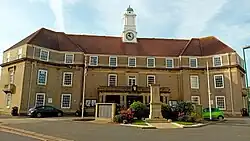Bognor Regis
Bognor Regis (/ˌbɒɡnər ˈriːdʒɪs/), also known as Bognor, is a town and seaside resort in West Sussex on the south coast of England, 56 miles (90 km) south-west of London, 24 miles (39 km) west of Brighton, 6 miles (10 km) south-east of Chichester and 16 miles (26 km) east of Portsmouth. Other nearby towns include Littlehampton east-north-east and Selsey to the south-west. The nearby villages of Felpham, and Aldwick are now suburbs of Bognor Regis, along with those of North and South Bersted. The population of the Bognor Regis built-up area, including Felpham and Aldwick, was 63,855 at the 2011 census.[5]
| Bognor Regis | |
|---|---|
 Bognor Regis' seafront as viewed from the pier in 2007 | |
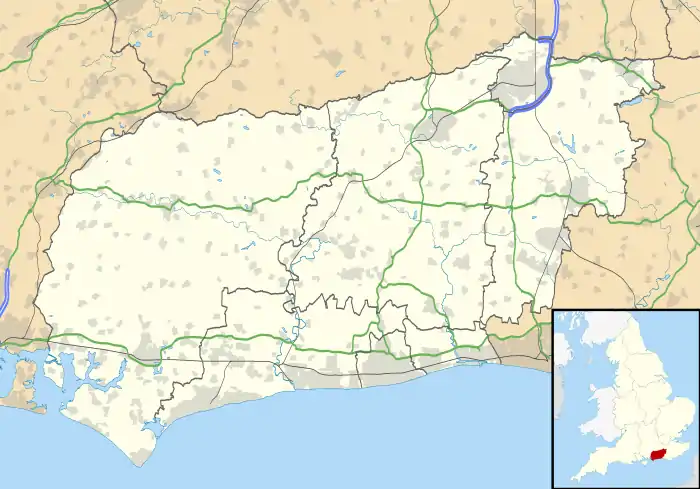 Bognor Regis Location within West Sussex | |
| Area | 4.41 km2 (1.70 sq mi) [1] |
| Population | 25,011 (Parish, 2021)[2] 68,435 (Built up area, 2021)[3] |
| OS grid reference | SZ934989 |
| • London | 55 miles (89 km) NNE |
| Civil parish |
|
| District | |
| Shire county | |
| Region | |
| Country | England |
| Sovereign state | United Kingdom |
| Post town | BOGNOR REGIS |
| Postcode district | PO21, PO22 |
| Dialling code | 01243 |
| Police | Sussex |
| Fire | West Sussex |
| Ambulance | South East Coast |
| UK Parliament | |
| Website | Bognor Regis Town Council |
| Arms of Bognor Regis Town Council | |
|---|---|
| Crest | On a Wreath of the Colours between two Gull's Wings Azure a Saxon Crown Gules. |
| Motto | To Excel |
| Granted to the urban district council on 10 April 1935.[4] | |
A seaside resort was developed by Sir Richard Hotham in the late 18th century on what was a sand and gravel, undeveloped coastline.[6] It has been claimed that Hotham and his new resort are portrayed in Jane Austen's unfinished novel Sanditon. The resort grew slowly in the first half of the 19th century but grew rapidly following the coming of the railway in 1864. In 1929 King George V spent three months in the area recuperating, and later that year the town's name was changed to "Bognor Regis" by royal consent. Butlin's has been present in the town since the early 1930s when an amusement park and zoo were opened. A holiday camp followed in 1960 and this has more recently moved towards hotel accommodation with modern amenities.[7]
Etymology
Bognor is one of the oldest recorded Anglo-Saxon place names in Sussex. In a document of AD 680, it is referred to as Bucgan ora meaning Bucge's (an Anglo-Saxon name) shore, or landing place.[8]
History
Bognor Regis was originally named just "Bognor", being a fishing (and smuggling) village, with a port or haven on the Aldingbourne Rife, until the 18th century when it was converted into a resort by Sir Richard Hotham who renamed the settlement Hothamton, although this did not catch on. It has been postulated that Hotham and his new resort are portrayed in Jane Austen's unfinished novel Sanditon.[9]
On the beach between Bognor Regis and Aldwick lies the wreck of a floating pontoon (caisson) which was once part of the Mulberry floating harbours used by the Allies to invade the French coast on D-Day 6 June 1944. It was a part of the Mulberry harbour which broke free in a storm on 4 June, the day before it was due to go over the channel to Arromanches. This particular section of Mulberry was abandoned and did not make it across the Channel. It was washed up on the beach shortly after D-Day.[10]
There is a memorial to the brave men who were involved in the Mulberry Harbour project. The memorial was placed there in June 1999, and states: "To mark the 55th Anniversary of D-Day in 1944. This plaque is erected as a memorial to mark the historical association that Pagham Beach had with the Mulberry Harbour Project in support of the liberation of Europe." The plaque continues 'some 50 had been assembled between Pagham beach and Selsey. To hide them from enemy view they were sunk to await refloating when the invasion got under way'. Finally, the plaque records "The Mulberry Harbour project was without doubt, a great feat of British and allied engineering skills, many still remain at Arromanches in Normandy."[11]
The historic meeting of the crews (and associated handshake) of the Apollo-Soyuz Test Project on 17 July 1975 was intended to have taken place over Bognor Regis, but a flight delay caused it to occur over Metz in France instead.[12]
Bognor Regis town centre was damaged in 1994 by an IRA device left in a bicycle outside Woolworth's. Fifteen shops were damaged but no injuries occurred.[13]
"Bugger Bognor"
King George V had become ill, requiring lung surgery to be carried out on 12 December 1928. His recovery was slow and on 22 January 1929 Buckingham Palace issued the statement saying "it has been realised by the King's medical advisers that, prior to the establishment of convalescence, there would arrive a time when sea air would be necessary in order to secure the continuation of His Majesty's progress". The Palace statement went on "with the knowledge, a careful search was made for a "residence" not only suitable in itself but possessing the necessary attributes of close proximity to the sea, southern exposure, protection from wind, privacy and reasonable access to and from London." The residence selected was Craigweil House, Bognor (demolished in 1939) placed at the king's disposal by owner Sir Arthur Du Cros who was a wealthy businessman, having acquired the house from Dr Stocker who bought it from the Countess of Newburgh who had constructed the building in 1806. The house was technically just outside Bognor, being at Aldwick in the neighbouring parish of Pagham.[7] Following his stay, the Bognor Urban District Council petitioned the king to bestow the suffix "Regis" ("of the King") on the town.[14] The petition was presented to Lord Stamfordham, the king's private secretary, who in turn delivered it to the king. King George supposedly replied, "Oh, bugger Bognor." Lord Stamfordham then went back to the petitioners and told them, "the King has been graciously pleased to grant your request."[15] The change of name from Bognor to Bognor Regis formally took effect on 26 July 1929.[16] Four years later in 1933 the town's boundaries were enlarged, with Craigweil House and Aldwick being within the area added.[17]
A slightly different version of the "Bugger Bognor" incident is that the King, upon being told, shortly before his death, that he would soon be well enough to revisit the town, uttered the words "Bugger Bognor!" Although there is little evidence that these words were actually spoken in this context, and although the sea air helped the King to regain his health, it is certain that the King had little regard for the town.[18]
Butlins
Billy Butlin made his first appearance in the town with his Recreation Shelter, which was situated on the corner of Lennox Street and the Esplanade. The Recreation Shelter was to prove to be a popular entertainment venue, containing one-armed-bandits and dodgem cars. This was eventually followed on 5 July 1933 by the Butlin Zoo on the seafront, which contained a wide array of animals, including brown, black and polar bears, hyenas, leopards, pelicans, kangaroos, monkeys and "Togo the snake king". Within three years, Billy Butlin was opening his first holiday centre at Skegness. Eventually, in 1958, the Bognor Regis town council announced that they had reached an agreement with Butlin to take on the 39 acre Brookland site to build a holiday camp, the site on which Butlins still stands today. The camp first opened to the public on 2 July 1960.[19]
Governance
There are three tiers of local government covering Bognor Regis, at parish (town), district and county level: Bognor Regis Town Council, Arun District Council and West Sussex County Council. The town council is based at the Town Hall on Clarence Road.[20]
Bognor was historically part of the ancient parish of Pagham and was also part of the wider Hundred of Aldwick, an ancient division of Chichester Rape. From around 1465 it was included in the parish of South Bersted. In 1822 improvement commissioners were established to govern the town. The commissioners were replaced by a local board in 1867. Such local board districts were reconstituted as urban districts in 1894, when the civil parish of South Bersted was also split; the part in the Bognor urban district became a parish called Bognor and the part outside the urban district became a parish called Bersted.[21] Bognor had already become a separate ecclesiastical parish from South Bersted in 1873.[9][22]
The urban district council built itself Bognor Regis Town Hall to serve as its headquarters. The building was designed by Charles Cowles-Voysey and completed in 1930.[23] The urban district was renamed Bognor Regis in 1929, and was significantly enlarged in 1933, absorbing the neighbouring parish of Felpham and the Aldwick area from the parish of Pagham.[17]
Bognor Regis Urban District was abolished in 1974, becoming part of Arun District. No successor parish was created for the former urban district at the time, and so it became an unparished area, directly administered by Arun District Council. Three new civil parishes were subsequently created covering the former urban district in 1985: Bognor Regis, Aldwick and Felpham.[24]
Geography
Town
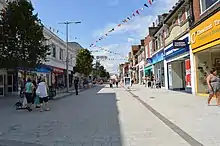
The town has several areas, and buildings, that still link it with its past. Good examples, and prominent local landmarks, are the Royal Norfolk Hotel and Hotham Park.
The Anglican parish church is dedicated to St. Wilfrid[25] while the local Roman Catholic church is Our Lady of Sorrows Church.
Bognor Regis lies within the constituency of Bognor Regis and Littlehampton, the MP for which is Nick Gibb (Conservative).
Climate
Bognor Regis experiences an oceanic climate (Köppen climate classification Cfb) similar to almost all of the United Kingdom albeit sunnier and milder due to its proximity to the coast - It has, at over 1,900 hours on average, the highest known annual level of sunshine of any British mainland weather station resulting in Bognor Regis being named the sunniest town in Britain.[26][27] Besides inhibiting summer cloud development, its coastal location also prevents extreme temperatures; Whereas locations in the Sussex Weald, to the North, can, on occasion, fall below −15.0 °C (5.0 °F) or rise above 35.0 °C (95.0 °F), since 1960, the temperatures recorded at Bognor have never fallen below −9.4 °C (15.1 °F)[28] (January 1963) or risen above 31.5 °C (88.7 °F)[29] (June 1976). Rainfall in Bognor peaks during the winter months, and reaches a minimum in summer, as is typical for the South Coast of England.
| Climate data for Bognor Regis (1991-2020 normals) | |||||||||||||
|---|---|---|---|---|---|---|---|---|---|---|---|---|---|
| Month | Jan | Feb | Mar | Apr | May | Jun | Jul | Aug | Sep | Oct | Nov | Dec | Year |
| Average high °C (°F) | 8.4 (47.1) |
8.6 (47.5) |
10.8 (51.4) |
13.5 (56.3) |
16.6 (61.9) |
19.2 (66.6) |
21.3 (70.3) |
21.4 (70.5) |
19.3 (66.7) |
15.7 (60.3) |
11.8 (53.2) |
9.1 (48.4) |
14.6 (58.4) |
| Average low °C (°F) | 3.4 (38.1) |
3.2 (37.8) |
4.4 (39.9) |
6.3 (43.3) |
9.1 (48.4) |
12.0 (53.6) |
14.1 (57.4) |
14.1 (57.4) |
12.0 (53.6) |
9.5 (49.1) |
6.2 (43.2) |
3.9 (39.0) |
8.2 (46.7) |
| Average precipitation mm (inches) | 82.5 (3.25) |
54.7 (2.15) |
45.8 (1.80) |
45.4 (1.79) |
42.8 (1.69) |
48.6 (1.91) |
43.7 (1.72) |
53.6 (2.11) |
57.1 (2.25) |
84.5 (3.33) |
87.5 (3.44) |
87.7 (3.45) |
733.9 (28.89) |
| Mean monthly sunshine hours | 74.7 | 92.8 | 137.2 | 197.8 | 235.0 | 237.9 | 253.7 | 232.7 | 176.6 | 129.9 | 85.4 | 65.1 | 1,918.8 |
| Source: [30] | |||||||||||||
Tourism

Billy Butlin opened one of his Butlin's Holiday Camps in Bognor in 1960. The camp later became known as Southcoast World until 1998 and is now known as Butlin's Bognor Regis Resort. In 1999 Butlin's erected a large indoor leisure park, the buildings construction sharing aspects similar with the Millennium Dome in London. In 2005, a new £10m hotel, called "The Shoreline" was unveiled at the Bognor Regis resort.[31] A second hotel "The Ocean" opened on the site in Summer 2009 and general landscaping and upgrading have also taken place. A third hotel "Wave" opened in Summer 2012.[32]
In 2017 Bognor Regis Town Council appointed a Town Crier to promote tourism. Jane Smith can be seen regularly during the year, giving proclamations in the town and along the seafront in her regal purple and gold livery.[33]
Culture and community
Birdman of Bognor
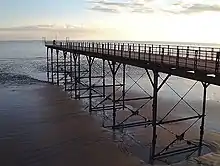
The International Bognor Birdman is an annual competition for human-powered 'flying' machines held each summer on Bognor Regis Pier. Contestants launch themselves from the end of the Grade II listed pier, a prize being awarded to the one who glides the furthest distance. Rarely taken completely seriously, the event provides competitors with an opportunity to construct improbable machines complete with outlandish dress, and is viewed as a display of British eccentricity.[34] The spectacle draws a sizeable crowd in addition to the local media. Inaugurated in nearby Selsey in 1971, the Birdman transferred to Bognor in 1978 when it had outgrown its original location. Competitors have included Richard Branson.
The Birdman Event of 2008 was transferred to Worthing after 60 feet (18 m) of the pier had been removed by the owners due to storm damage in March 2008. This meant that there were question marks over the possible safety of the contestants landing in shallower water. The shortened pier was judged safe for the event in 2010, and the event subsequently returned to Bognor.[35]
Music scene and festivals
Each summer Bognor Rox free music and arts festival is held.[36] 2015 was to be the 25th anniversary of the ROX Music and Arts Festival which attracts over 30,000 visitors[37] and features many genres of music in seven performance areas over two days.[38] The town is also home to the Bognor Regis Concert Band, who perform at various local locations and events, including the yearly "Proms in the Park" hosted at Hotham Park.[39]
Theatre and cinema
The Picturedrome Cinema in London Road has been trading as a cinema for over 100 years. It has been extensively refurbished, the freehold having been acquired by the Bognor Regis Town Council to secure the building's future, after extensive consultation.[40]
The Alexandra Theatre is a 357-seat auditorium showing a variety of entertainment from comedy to drama to pantomime. It was built in 1979 on the site of the former Edwardian Theatre Royal complex. It is currently run by a voluntary trust and shows a mixture of local groups, tribute bands and concerts.[41][42][43]
The film The Punch and Judy Man (1963), starring Tony Hancock, was partly shot in Bognor Regis. Several scenes of the film Wish You Were Here (1987) were also filmed in Bognor Regis.[44][45] The BBC series Don't Forget the Driver (2019) starring Toby Jones was filmed and set in Bognor.[46]
Community facilities
Bognor Regis War Memorial Hospital first opened in 1919 and is managed by the Sussex Community NHS Trust.[47]
Media
Local news and television programmes are provided by BBC South and ITV Meridian. Television signals are received from the Rowridge TV transmitter. [48]
The town’s local radio stations are BBC Radio Sussex on 104.8 FM, Heart South on 96.7 FM, Greatest Hits Radio West Sussex on 102.3 FM and Passion Radio, a DAB radio station.
Bogner Regis Observer is the town’s local newspaper. [49]
Education
Bognor Regis has two secondary schools, The Regis School and Felpham Community College. The area also has several primary schools, both in Bognor Regis and Felpham.[50]
Bognor Regis also hosts a university campus of the University of Chichester.[51]
Sport
Bognor Regis Town F.C. plays in the Isthmian Premier Division. They play their home games at Nyewood Lane.
Middleton & Bognor Hockey Club play their home matches at Littlehampton Academy.[52]
There are two cricket clubs: Bognor Regis Cricket Club and Pagham Cricket Club.[53][54]
Transport
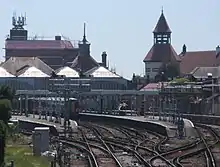
Bognor Regis railway station is on a branch line from Barnham, on the West Coastway Line. It has half-hourly services to London and to other south coast towns, some being direct. Trains are operated by Southern using Class 377s and Class 313s.
Politics
Since 1997 Bognor Regis has been in the parliamentary constituency of Bognor Regis and Littlehampton. Prior to this, it was in the constituencies of Arundel (1974–1997) and Chichester (1885–1974). Bognor is an electoral ward of Arun District.[55]
Twin towns
Bognor Regis is twinned with:
 Saint-Maur-des-Fossés, France[56]
Saint-Maur-des-Fossés, France[56] Weil am Rhein, Germany
Weil am Rhein, Germany Trebbin, Germany
Trebbin, Germany
Notable people
- Frederick Albert Bridge (1841–1917), photographer, died after a fall while on holiday in Bognor.[57]
- Sir Richard Hotham (1722–1799), property developer and politician associated with the development of Bognor Regis as a seaside resort.[58]
- Edward Morris (1940-2016), art historian, born in Bognor.[59]
- Cynthia Payne (1932–2015), brothel keeper, born in Bognor.[60]
- The Formula One driver David Purley (1945–1985), best known for his attempt to save the life of fellow racing driver Roger Williamson during the 1973 Dutch Grand Prix, was born in Bognor Regis, where he was killed after crashing his aerobatic biplane into the sea off Bognor on 2 July 1985.[61]
- Dante Gabriel Rossetti (1828–1882), one of the founders of the Pre-Raphaelite Brotherhood, painter and poet; worked at a studio in Belmont Street from 1875 to 1876.[62]
- Eric Coates (1886–1957), composer of marches and rhapsodies including The Knightsbridge March, By the Sleepy Lagoon and the Dambusters March.[63]
- James Joyce (1882–1941), novelist, author of Ulysses; worked on Finnegans Wake while staying in Bognor in 1923.[64]
- Mary Wheatland (1835–1924) swimming instructor and lifesaver. Saved over 30 people from drowning off the town's beaches.[65]
- William Blake (1757-1827) artist, mystic, visionary and poet. Lived in Felpham for 3 years while apprenticed to William Hayley, to whom he famously said ‘I hope we are enemies, for friendship’s sake’. There is a stained glass window in St Mary’s Norman church opposite Blake’s Cottage on Blake’s Road commemorating Blake’s stay in Felpham. ‘Away to sweet Felpham, for heaven is there, the ladder of angels descends through the air.’ (Blake)
See also
References
Notes
- "2001 Census: West Sussex – Population by Parish" (PDF). West Sussex County Council. Archived from the original (PDF) on 8 June 2011. Retrieved 29 March 2009.
- "Bognor Regis parish". City Population. Retrieved 8 October 2023.
- "Towns and cities, characteristics of built-up areas, England and Wales: Census 2021". Census 2021. Office for National Statistics. Retrieved 8 August 2023.
- "BOGNOR REGIS TOWN COUNCIL (W SUSSEX)". Robert Young. Archived from the original on 22 January 2021. Retrieved 31 October 2019.
- "City Population (ONS)". Archived from the original on 7 November 2018. Retrieved 7 November 2018.
- "Literature Review - Pagham to Shoreham-by-Sea Sediment Transport Study". www.scopac.org.uk. Archived from the original on 27 May 2021. Retrieved 11 February 2021.
- "A Brief History of Bognor Regis". Localhistories.org. Archived from the original on 2 September 2017. Retrieved 21 August 2017.
- Glover, J: Sussex Place Names pp. 31-32. Countryside Books, 1997
- Salzman L. F., ed. (1953). A History of the County of Sussex: Volume 4 - The Rape of Chichester. pp. 226, 227. Archived from the original on 17 October 2013. Retrieved 26 May 2014.
- "Mulberry harbour at Bognor Regis". Archived from the original on 26 January 2021. Retrieved 14 February 2021.
- "History of Pagham". Pagham Parish Council. Archived from the original on 25 November 2020. Retrieved 14 February 2021.
- "NASA History: SP-4209 The Partnership: A History of the Apollo-Soyuz Test Project; 17 July-The Rendezvous". Archived from the original on 24 May 2011. Retrieved 12 July 2017.
- "The day an IRA bomb in Bognor's Woolworths caused mayhem". Chichester Observer. 18 December 2008. Archived from the original on 19 December 2009. Retrieved 3 February 2009.
- "Bognor Regis Why Bognor "Regis"? in Bognor Regis". Bognor-regis.co.uk. Archived from the original on 18 February 2009. Retrieved 7 July 2009.
- Antonia Fraser, ed. (2000). The house of Windsor. A royal history of England. University of California Press. p. 36. ISBN 0-520-22803-0.
- "Bognor Regis Urban District Council". Bognor Observer. 31 July 1929. p. 8. Retrieved 8 October 2023.
...Bognor Urban District Council... have changed the name of their district from "Bognor" to "Bognor Regis" as from the 26th July 1929...
- "Bognor Regis Parochial Area / Civil Parish". A Vision of Britain through Time. GB Historical GIS / University of Portsmouth. Retrieved 8 October 2023.
- Rose, Kenneth (1983). King George V. London: Weidenfeld and Nicolson. pp. 359–361. ISBN 978-0-297-78245-2. Archived from the original on 27 May 2021. Retrieved 11 February 2021.
- "Butlins Holiday Camp Bognor Regis". British Film Institute. Archived from the original on 27 May 2021. Retrieved 14 February 2021.
- "Contact us". Bognor Regis Town Council. Retrieved 8 October 2023.
- "Bognor Regis Urban District Council". Discovery. The National Archives. Retrieved 8 October 2023.
- "Bognor Regis UD". Vision of Britain. Archived from the original on 5 March 2016. Retrieved 14 February 2021.
- Historic England. "Bognor Regis Town Hall (1350337)". National Heritage List for England. Retrieved 14 February 2021.
- "The Arun (Parishes) Order 1985" (PDF). Local Government Boundary Commission of England. The National Archives. Retrieved 8 October 2023.
- St Wilfrid's Parish Church – Bognor Regis Archived 4 May 2018 at the Wayback Machine, accessed May 2018.
- "The Telegraph: Bognor Regis the sunniest spot in Britain". Archived from the original on 6 December 2011. Retrieved 3 April 2018.
- Met Office: Highest Annual Sunshine Archived 14 March 2012 at the Wayback Machine
- "1963 temperature". KNMI. Archived from the original on 8 June 2012. Retrieved 10 November 2011.
- "1976 temperature". KNMI. Archived from the original on 8 June 2012. Retrieved 10 November 2011.
- "Bognor Regis Climate". Retrieved 16 December 2021.
- "No place like holidaying at home". Archived from the original on 24 February 2007. Retrieved 25 September 2007.
- "A Third Butlin's Hotel is planned". Archived from the original on 4 May 2009. Retrieved 10 May 2009.
- "Bognor Regis Touwn Council". Archived from the original on 22 January 2021. Retrieved 19 September 2020.
- "Strong winds dash birdmen's hopes". BBC News. 22 July 2001. Retrieved 23 July 2021.
- "Birdman Pier Length Investigations". Archived from the original on 11 June 2011. Retrieved 17 September 2010.
- Rox festival Archived 29 October 2020 at the Wayback Machine Rox homepage
- Observer, bognor. "ROX Music and Arts Festival 2012". Bognor Regis Observer. Archived from the original on 6 January 2014. Retrieved 25 April 2013.
- Observer, Bognor. "Musicians flock to show support for ROX festival". The Bognor Regis Observer. Archived from the original on 6 January 2014. Retrieved 25 April 2013.
- "Bognor Regis Concert Band Official Site". Archived from the original on 11 May 2011. Retrieved 16 May 2011.
- Blackler, Tom. "Picturedrome website". Archived from the original on 4 March 2016. Retrieved 2 March 2016.
- "Regis Centre". Theatres Trust. Archived from the original on 5 November 2018. Retrieved 15 June 2017.
- "Venue Hire". Regis Centre. Archived from the original on 19 March 2017. Retrieved 15 June 2015.
- "What's On". Regis Centre. Archived from the original on 9 July 2017. Retrieved 15 June 2017.
- Hewitt, Phil (4 February 2012). "Anniversary of comedy legend's visit to be marked". West Sussex Gazette. Archived from the original on 1 July 2018. Retrieved 14 June 2017.
- "Movie legend comes to town for special screening". Bognor Regis Observer. 17 April 2007. Archived from the original on 5 November 2018. Retrieved 14 June 2017.
- "BBC Two: Don't forget the driver". Archived from the original on 22 January 2021. Retrieved 17 May 2019.
- Tim Lambert. "Bognor in the 20th Century". localhistories.org. Archived from the original on 12 June 2017. Retrieved 10 June 2017.
- https://ukfree.tv/transmitters/tv/Rowridge
- https://www.britishpapers.co.uk/england-se/bognor-regis-observer/
- bognorregis Archived 5 February 2008 at the Wayback Machine Schools in Bognor Regis
- "University of Chichester guide". The Telegraph. 29 July 2016. Archived from the original on 22 August 2017.
- "Middleton and Bognor Hockey Club Club". Middletonandbognorhc.co.uk. Archived from the original on 23 August 2012. Retrieved 12 March 2013.
- "Home". Bognorregiscricketclub.co.uk. Archived from the original on 7 May 2013. Retrieved 12 March 2013.
- "Pagham Cricket Club". Pagham Cricket Club. Archived from the original on 8 August 2013. Retrieved 12 March 2013.
- "Arun District: Ward Profiles". Archived from the original on 22 April 2019. Retrieved 22 April 2019.
- "British towns twinned with French towns [via WaybackMachine.com]". Archant Community Media Ltd. Archived from the original on 5 July 2013. Retrieved 20 July 2013.
- "Bridge, Frederick Albert". Archived from the original on 30 May 2016. Retrieved 15 June 2017.
- Endacott, Sylvia (8 August 2014). "Sir Richard Hotham". Archived from the original on 19 August 2017. Retrieved 15 June 2017.
- "Edward Morris". The Times. 22 July 2016.
- "Cynthia Payne, madam - obituary". The Daily Telegraph. 16 November 2015. Archived from the original on 19 November 2015. Retrieved 19 November 2015.
- Autocourse G'Prix Archive Archived 22 December 2007 at the Wayback Machine
- "Blue plaque". Archived from the original on 12 February 2019. Retrieved 10 February 2019.
- "Musicweb: Eric Coates". Archived from the original on 13 August 2017. Retrieved 10 February 2019.
- Simon Calder. "The man who pays his way". Independent. Archived from the original on 12 February 2019. Retrieved 10 February 2019.
- "Plaque to bathing machine operator Mary Wheatland to be unveiled on Bognor Regis seafront". www.sussexexpress.co.uk. 10 October 2022. Retrieved 15 October 2022.
External links
- Bognor Regis Town Council
- . Encyclopædia Britannica (11th ed.). 1911.
